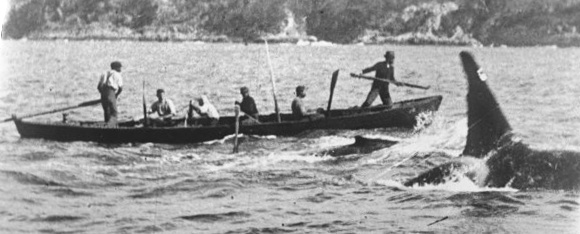The Loch Duich Thing
Posted by: Nick Redfern on May 29th, 2012

Over at the Loch Ness Mystery blog, there’s an interesting new post (including a photo, which is also shown in close-up) of an old story that is guaranteed to catch the attention of devotees of all-things lake-monster-based.
Precisely what the picture – taken in 1953 at Loch Duich, Scotland – shows is quite another matter! The appendage of a killer-whale? The head and neck of a mystery animal? Take a look and see for yourself…
And, as you’ll see from this link, Loch Duich has a very controversial Loch Ness Monster link attached to it too, as well as a curious legend of “seal-maidens” inhabiting its waters…
Note: the old, copyright-expired photo above is used for illustration only. It’s not from the loch itself.
About Nick Redfern
Punk music fan, Tennents Super and Carlsberg Special Brew beer fan, horror film fan, chocolate fan, like to wear black clothes, like to stay up late. Work as a writer.










That is without a doubt, a pod of killer whales.
The angle at which the surfacing “piece” comes off of what’s in the water says fin to me too. A head and neck would be less at right angles and more of a slope going from head to neck to body…even if it was sticking its head straight up…which I’m not sure if it could do. 🙂
So, from the pic and the account, I’m going with whale too. How an orca got in there, I don’t know…don’t have enough info at the moment to know if Loch Duich has an opening to the sea or not…still, interesting to say the least.
the Orca explaination sounds best, a mum and calf – the calf you can see by the boat.
Sea loch = whales likely for anything that looks like one.
I’m a sad b*st*rd (especially when you realise I covered a lot of Earth Science at uni) but for the first time ever I took a look at Loch Ness on a map and suddenly my belief it was perfectly isolated was shattered because there it is right on the Great Glenn Fault (GGF) which to me means there must’ve been plenty of opportunities for things to get in and out there from or to the sea right upto the end of the last Ice Age.
In fact I wouldn’t be surprised if there’s still routes in/out intact down there to this day (their entrances/exits quite possibly being opened or closed by ‘seasonal’ gravitic effects of the moon).
I’m sure someone’ll tell me I’m wrong but I beg to differ – it’s possible.
Springheeledjack, Loch Duich is a sea loch – open access to the sea.
It is interesting how much a still picture of a male killer whale’s fin can resemble the traditional head and neck sighting – but I think it’s a mistake that would be difficult to make with a live animal in front of you, since the “monster” would appear to be swimming backwards! I think there’s little doubt from both the picture and the account this is a killer whale.
As a commenter said over on the Loch Ness blog, Loch Duich does have another interesting monster connection, in that it’s the site of one of the pieces of footage supposedly taken by Dr MacCrae and since locked up in mysterious trust (the other one supposedly taken in Loch Ness).
Undoubtledly a killer whale, probably a male, and maybe a transient–which means it eats mammals not fish. The picture even shows the grey saddle patch. So, about 35 miles away from Loch Ness there could be killer whales prowling the coasts. I imagine that would spawn more than a few legends of sea monsters.
I believe the picture reproduced here with the boat is just for illustrative purposes – you can see the one under discussion if you follow the link. It’s less clear. But still a killer whale, IMHO. It is no mystery that there are killer whales in the waters off the Scottish coast.
alan borky wrote “… (Loch Ness) is right on the Great Glenn Fault (GGF) which to me means there must’ve been plenty of opportunities for things to get in and out there from or to the sea right upto the end of the last Ice Age.
In fact I wouldn’t be surprised if there’s still routes in/out intact down there to this day (their entrances/exits quite possibly being opened or closed by ’seasonal’ gravitic effects of the moon).”
OK, I’ll tell you why I think you are wrong! Up to the end of the last Ice Age there was a glacier in the Great Glen. A glacier is not a lake with a frozen surface but a river of ice and rock formed from snowfall. In the Great Glen the ice was around 600 metres thick and the nearest “sea” was hundreds of miles away to the South and 125 metres below its present level.
As for routes intact to this day, if you are suggesting water-filled tunnels connecting modern Loch Ness to the sea some 7 miles away, these would be of no use to mammals and reptiles as the poor creatures would drown, no use to amphibians as they would die in the sea water, and not needed by fish which can easily swim up and down the River Ness. There is also the 16 metre difference in levels between Loch Ness and the sea to be considered.
I would very much like to see examples of “entrances/exits (to anything, anywhere) quite possibly being opened or closed by ’seasonal’ gravitic effects of the moon” and I look forward to your reply.